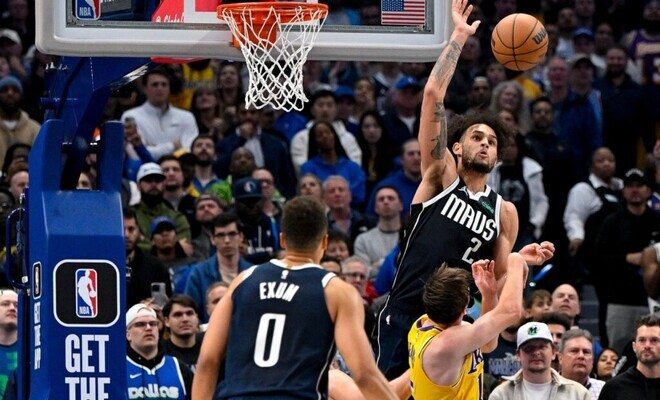-
 June 19, 2024, 1:56 pm
June 19, 2024, 1:56 pmLast Updated on August 19, 2025 7:20 pm by André Lemos | Published: June 19, 2024
The Mavs have finally found their star partner for Luka Doncic in Kyrie Irving. Surrounded by complementary defensive wings and centers, they finally made a run to the NBA Finals. The only hurdle that remains is the greatest one left – can they get over the final hump?
How’d It Go?
After the Mavs acquired Kyrie Irving at last year’s trade deadline and successfully tanked…sorry Adam Silver, I mean “lost”…their way into keeping their top-10 pick, they aimed to build around their new core of Luka Doncic and the aforementioned Irving. The roster additions in the offseason were made with Doncic and Irving dominating the offensive usage in mind, with the rest of roster providing defensive coverage and off-ball offensive aid in the form of shooting and cutting.
For the large part, the Mavs’ plan worked. It did need a trade deadline shakeup to tune up the concept with the additions of P.J. Washington and Daniel Gafford (at the cost of Grant Williams and others), but those changes were key in a run to the NBA Finals. Only three Mavs players averaged more than 10 field goal attempts per game: Doncic at 23.6, Irving at 19.5, and Washington at 10.4, barely making the cut. This demonstrates the reliance the Mavs had on Doncic and Irving on the offensive end, and they were able to respond with huge offensive seasons.
Defensively, the Mavs utilized a hodgepodge of defensive wings and big men to shut off the rim. We’ll get more into their defensive schemes later, but the Mavs finally found the right recipe around Doncic in this regard. Pair Doncic with another shot generator to help lessen the offensive load, find players who can thrive in a sheltered defensive role, and watch the wins follow. Post All-Star break, the Mavs were 18-9, good for fourth in the league. Credit to them – they found a formula that worked, tweaked it, and now have the makings of a contender.
Coaching
Against all odds, Jason Kidd has managed to improve himself to be a positive coach in the NBA. While he adds some value on the offensive end, Kidd has shown his true addition to be on defense. He has excelled in game planning against teams in the playoffs, scheming well to enhance his own players while mitigating other teams’ strengths. This was on full display in the playoff series versus the Thunder and the Wolves. Against the Thunder, Kidd had his defenders stay packed near the paint and challenged the non-Shai Gilgeous-Alexander players to make and create shots. SGA did his part offensively, but the rest of the team struggled against the length of the Mavs’ defenders. Squared up against the Wolves, Kidd employed a similar strategy with the additional wrinkle of ignoring any non-shooters like Kyle Anderson and Rudy Gobert. Anthony Edwards was forced to drive into the paint into as many as three Mavs defenders at a time; no player in the league is scoring effectively with those odds. You could tell just how well-prepared the Mavs where scarcely-used non-shooter Jordan McLaughlin entered Game 5 for a few minutes. The Mavs defense instantly completely ignored McLaughlin, daring him to take shots from deep (which he promptly did not do).
Another coaching element Kidd added was the handling of Dereck Lively II and Daniel Gafford at the center position. Both similar archetypes, Kidd did not really use one player more over the other. Instead, he would run them out for shorter stints. This allowed Lively II and Gafford to play near full energy levels for their minutes and create a situation where the Mavs would have 48 minutes of energized athletic center play. It’s hard to say if other teams would also employ this strategy given the lack of relatively equal center talents, but the fact remains that Kidd did exact this strategy. We have to give some credit where it is due. Kidd has had some disastrous moments as a coach, but he seems to have figured it all out.
The Players
Luka DončićPG, Los Angeles LakersSeason Team GP GS MPG FGM FGA FG% FTM FTA FT% 3PTM 3PTA 3PT% PTS REB AST STL BLK TO 25-26 LAL 22 22 36.5 10.4 22.6 46.1 9.5 11.9 80.1 3.4 10.5 32.2 33.7 8.5 8.7 1.5 0.6 4.3 24-25 LAL 50 50 35.4 9.2 20.5 45.0 6.2 7.9 78.2 3.5 9.6 36.8 28.2 8.2 7.7 1.8 0.4 3.6 23-24 DAL 70 70 37.5 11.5 23.6 48.7 6.8 8.7 78.6 4.1 10.6 38.2 33.9 9.2 9.8 1.4 0.5 4.0 ADP: 4.2/2.7 (ESPN/Yahoo) | Total Value: 4/4 (8/9-cat) | Per-Game Value: 3/5 (8/9-cat)
Luka Doncic finally justified his early first round ADP. What changed this year from previous seasons? First, Doncic upped his three-point volume and accuracy, hitting 4.1 triples per-game at a 38.2% clip. Those numbers were previously 2.8 and 34.2% respectively. He actually hit the second-most triples in the league per-game and was a great boost in that regard for fantasy managers.
Second, Doncic improved his FT% from 74.2% to 78.6%. This may not sound like a drastic improvement, but when Doncic is taking 8.7 free-throw attempts per-game, the impact adds up fairly quickly. Doncic’s FT% became something you could manage versus a complete drain, helping to round out his fantasy profile.
Add on some modest improvements in points, boards, and assists, and you have the makings of a top-five fantasy player. The threes are likely to stay, but perhaps we could see regression in FT% to Doncic’s career norms of 74.7%. That being said, he brings so much value in counting stat categories that most drafters will take the risk. He is locked in as a top-five pick in redraft leagues.
Want access to the rest of this Season Wrap? You’ll need to have a FANTASYPASS membership. Click here to learn more and sign up!
